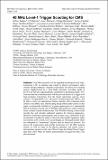| dc.contributor.author | Paus, Christoph M. E. | |
| dc.contributor.author | Darlea, Georgiana-Lavinia | |
| dc.contributor.author | Gomez-Ceballos, Guillelmo | |
| dc.date.accessioned | 2022-04-27T14:56:13Z | |
| dc.date.available | 2022-04-27T14:56:13Z | |
| dc.date.issued | 2020 | |
| dc.identifier.uri | https://hdl.handle.net/1721.1/142124 | |
| dc.description.abstract | <jats:p>The CMS experiment will be upgraded for operation at the HighLuminosity LHC to maintain and extend its physics performance under extreme pileup conditions. Upgrades will include an entirely new tracking system, supplemented by a track finder processor providing tracks at Level-1, as well as a high-granularity calorimeter in the endcap region. New front-end and back-end electronics will also provide the Level-1 trigger with high-resolution information from the barrel calorimeter and the muon systems. The upgraded Level-1 processors, based on powerful FPGAs, will be able to carry out sophisticated feature searches with resolutions often similar to the offline ones, while keeping pileup effects under control. In this paper, we discuss the feasibility of a system capturing Level-1 intermediate data at the beam-crossing rate of 40 MHz and carrying out online analyzes based on these limited-resolution data. This 40 MHz scouting system would provide fast and virtually unlimited statistics for detector diagnostics, alternative luminosity measurements and, in some cases, calibrations. It has the potential to enable the study of otherwise inaccessible signatures, either too common to fit in the Level-1 accept budget, or with requirements which are orthogonal to “mainstream” physics, such as long-lived particles. We discuss the requirements and possible architecture of a 40 MHz scouting system, as well as some of the physics potential, and results from a demonstrator operated at the end of Run-2 using the Global Muon Trigger data from CMS. Plans for further demonstrators envisaged for Run-3 are also discussed.</jats:p> | en_US |
| dc.language.iso | en | |
| dc.publisher | EDP Sciences | en_US |
| dc.relation.isversionof | 10.1051/EPJCONF/202024501032 | en_US |
| dc.rights | Creative Commons Attribution 4.0 International license | en_US |
| dc.rights.uri | https://creativecommons.org/licenses/by/4.0/ | en_US |
| dc.source | EDP Sciences | en_US |
| dc.title | 40 MHz Level-1 Trigger Scouting for CMS | en_US |
| dc.type | Article | en_US |
| dc.identifier.citation | Paus, Christoph. 2020. "40 MHz Level-1 Trigger Scouting for CMS." EPJ Web of Conferences, 245. | |
| dc.contributor.department | Massachusetts Institute of Technology. Laboratory for Nuclear Science | |
| dc.relation.journal | EPJ Web of Conferences | en_US |
| dc.eprint.version | Final published version | en_US |
| dc.type.uri | http://purl.org/eprint/type/ConferencePaper | en_US |
| eprint.status | http://purl.org/eprint/status/NonPeerReviewed | en_US |
| dc.date.updated | 2022-04-27T14:47:10Z | |
| dspace.orderedauthors | Badaro, G; Behrens, U; Branson, J; Brummer, P; Cittolin, S; Da Silva-Gomes, D; Darlea, G-L; Deldicque, C; Dobson, M; Doualot, N; Fulcher, JR; Gigi, D; Gladki, M; Glege, F; Golubovic, D; Gomez-Ceballos, G; Hegeman, J; James, TO; Li, W; Mecionis, A; Meijers, F; Meschi, E; Mommsen, RK; Mor, K; Morovic, S; Orsini, L; Papakrivopoulos, I; Paus, C; Petrucci, A; Pieri, M; Rabady, D; Raychinov, K; Racz, A; Rodriguez-Garcia, A; Sakulin, H; Schwick, C; Simelevicius, D; Soursos, P; Stahl, A; Stankevicius, M; Suthakar, U; Vazquez-Velez, C; Zahid, A; Zejdl, P | en_US |
| dspace.date.submission | 2022-04-27T14:47:11Z | |
| mit.journal.volume | 245 | en_US |
| mit.license | PUBLISHER_CC | |
| mit.metadata.status | Authority Work and Publication Information Needed | en_US |
